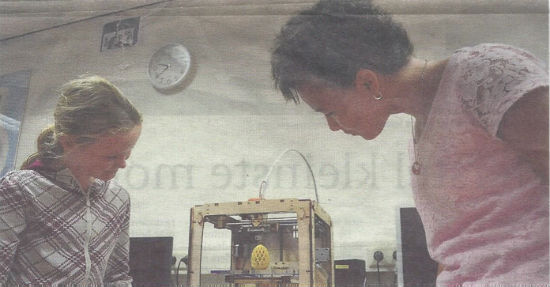
Three Friesian schools want to reinforce their educational programme with three dimensional computer techniques. This week they started on an international project on the island of Vlieland.Jonathan Keep is lying stretched out on the floor with his laptop. The English artist shows on the screen next to him how he digitally reshapes cubes, spheres and cylinders. The presentation is typical for the casual atmosphere at vmbo-school De Krijtenburg. Schools from five countries have come together on Vlieland to introduce 3D designing and printing to their students.
Because this is what they believe to have the future. After all, we will soon be able to make anything with a printer. From prostheses and jewellery to tools and weapons. Transportation costs will be history. The children from Vlieland Luca Brand, Raf Houter, Lydia Matoren (obs De Noordster) and Esmee van Krimpen and Simone Elsinga (Krijtenburg) are allowed first to get acquainted with the equipment. “They are the ones that are going to show the teachers how to teach in this area,” says Dutch initiator Eileen Blackmore of House of Design.
Ben Matoren, director of De Krijtenburg, is enthusiastic about the project. “Children learn how to think in a three dimensional way in an early stage. A 3D printer is definitely no game. We want to teach the children not to copy, but to create.” In order to make this work, artists and designers from each country have come to Vlieland. Jonathan Keep shows how he can manipulate figures. He can even do it with sound. By tapping on the floor, a vase gets a whimsical shape. “This way you can also reshape an object with bird sounds or music,” he instructs the teachers of Vlieland and Leeuwarden (obs De Wielen, Cammingaburen). Keep’s printer pours out clay, building up an object layer by layer. The final product is baked and glazed in the oven.
The usual 3D printer uses plastic to print with. Project partner Fryslân promotes the use of biodegradable plastics. Besides this, the province wants to investigate the use of plastic waste as a source material. “It is also possible to print with a mixture of plastic, wood and nylon,” Esmee van Krimpen of de Krijtenburg has learned. On the second day, the designers exchange their first experiences with the teachers. Blackmore for example has a practical point: “The printing takes a long time. That’s why we have thought of something while we were at the festival on Vlieland. While the printer is printing, the children could assemble a wooden car and pimp it. They could attach their printed object on the car when it was finished.”
The Swedish artist encouraged the children build with paper first, to trigger their spatial insight. The Portuguese artist insists on the importance of the design phase; draw ‘flat’ first, then move on to the three dimensional elaboration. Her British colleague has a different approach. “Start with clay, that is three dimensional already.” The exchange project is having a follow-up at the end of January in Sweden. The theme there will be recycling. The programme will emerge while people are working on it. “That’s the fun part of these kind of projects,” according to Simon Tijsma, officer for the province of Fryslân. “First you have to believe, and then see. It is a question of dreaming, daring and doing. We as government create only the dancing floor.”
(Source: Leeuwarder Courant)
Photo: LC
